Encana and the Lifespan Planning Approach
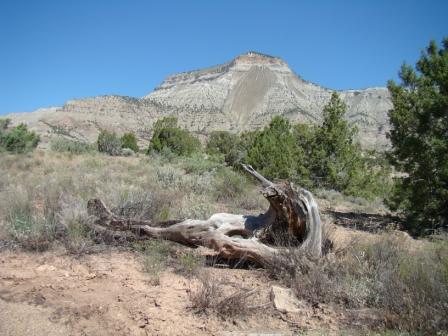
|
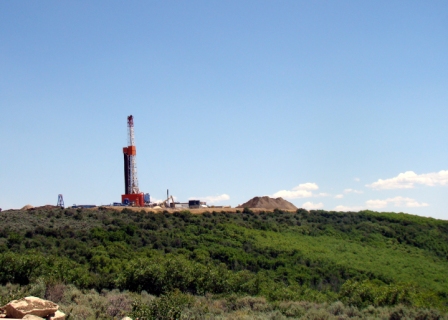 |
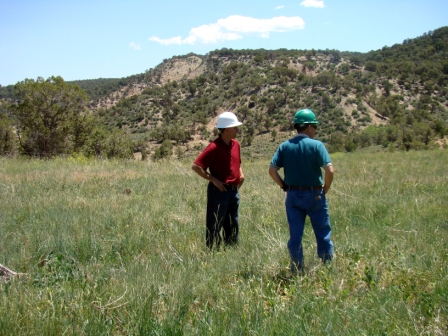 |
| An undisturbed portion of Encana's lease lands in Parachute, Colorado. |
An actively-drilling well pad surrounded by high berms. |
A reclaimed pasture surrounding a producing well pad. |
Introduction
Encana Oil and Gas USA is a progressive company that has worked to define itself as a high growth, low-cost leader in unconventional natural gas production. In their vision statement, Encana emphasizes the company’s shared set of moral principles that guide behavior and company activities. These principles coupled with knowledgeable and dedicated employees have resulted in recognition for Encana for their reclamation technologies and BMPs, cost structures that are among the lowest in industry, and community outreach efforts.
Guiding these practices and efforts is what Encana calls their Lifespan Planning Approach (LPA) to natural gas extraction. Encana has found that successful initial reclamation, guided every step of the process by Lifespan Planning, can greatly increase final reclamation success and significantly lower costs by eliminating the direct and indirect costs of failed reclamation attempts. Every Encana well pad since 2008 has been drilled with this approach in mind.
The LPA requires thorough site inventory and analysis and the implementation and maintenance of BMPs based on this inventory and analysis. To accomplish this task, Encana utilizes about 20 highly trained personnel to work each well pad. Each site has a Reclamation Coordinator, a geologist, a reservoir engineer, an environmental field coordinator, 3-6 hired contractors, and supervisors for those listed. The Reclamation Coordinator designs the build with Lifespan Planning in mind, the permitting person files necessary paperwork, then the team dynamically works toward completion, every step of the way stopping to ask questions about overall efficiency.
BMPs for Lifespan Planning and Successful Reclamation
Encana’s Site Inventory and Analysis
Encana performs site inventory and analysis months to years in advance, depending on location and lease conditions, in order to avoid delaying the drilling process. Despite this, Parachute, Colorado Encana Reclamation coordinator, Bryan Whiteley, insists that Lifespan Planning isn’t time consuming, it just involves thoughtful analysis of available information every step of the way in order to maximize efficiency. Geologists decide where they’d like a surface location in an area of known mineral rights and analyze the site for the maximum amount of wells the site could potentially hold. Once the limits of the site are established, inventory and analysis of wild communities guide the Reclamation Coordinator as he designs the build. The entire lifespan, including all phases of drilling, production, and reclamation, of the location is considered prior to drilling activity.
Site Inventory and Analysis BMPs
Locate facilities and access roads to minimize slope and stormwater runoff
Inventory Soil
Inventory Vegetation Species
Inventory Drainage Basin or Watershed Information
Inventory Noxious Weeds
Analyze inventoried information |
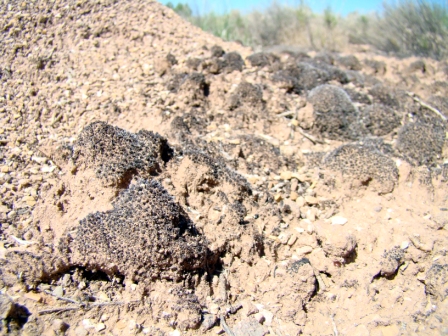
Site Inventory on Encana lease lands in Parachute, Colorado reveals cryptogamic soils. These are cyanobacterial colonies that build "towers" with layers of algae, dirt, and sometimes lichens. Cryptogamic organisms help to stabilize the soil, hold moisture, and provide protection for germination of the seeds of other plants. Encana avoids operating on or around cryptogamic soils, and routinely applies appropriate cyanobacteria to promote cryptogamic soil growth. |
Reduce Sediment Loads
Grade pads and install terraces, berms, benches, etc. to reduce sediment loading during construction and operations and for interim and final reclamation.
Use geomorphic landforming and earthen hydrological controls. |
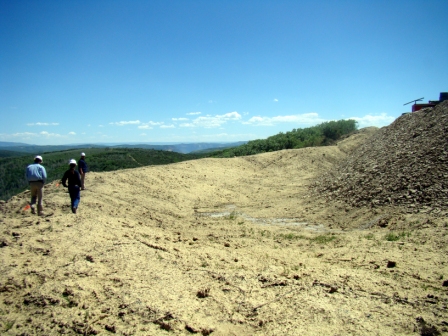
Primary and secondary containment berms on an Encana active drilling pad. High primary berms provide noise and visual impact relief in addition to minimizing stormwater pollution and sediment deposits into watersheds. Secondary berms coated in sawdust provide additional protection against watershed pollution in the event of a spill. Both berms are made using on-site materials to minimize the need and costs associated with importing materials from off-site locations. |
Soil Amendments
Apply the proper types and amounts of soil amendments when topsoil is lacking or poor quality
Organic fertilizers and humates are used on both Pioneer Natural Resources Company and Encana sites with success. These amendments are cost effective and easy to apply by broadcasting or mixing in hydromulcher)
Perform proper soil tillage to loosen compaction |
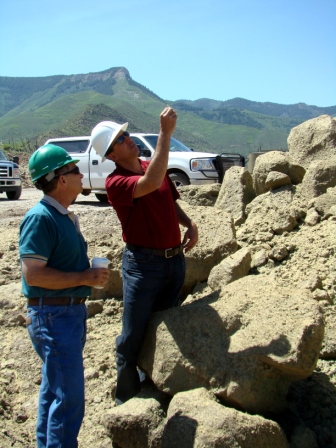
An Encana employee holds up, examines, and explains the use of mulch and sawdust on containment berms. Woody materials laid down over berms help minimize erosion of berms during well operations, help increase water retention of soils, and help prevent weed contamination. |
Seeding
Design proper seed mixtures and application rates
Utilize adapted and native grasses, forbs and shrubs |
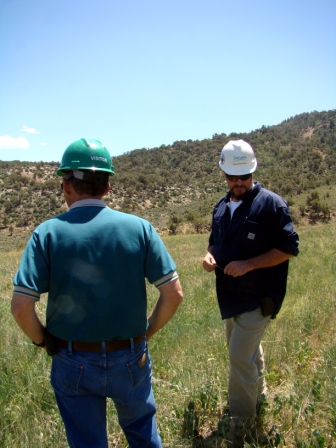
Encana Reclamation coordinator, Bryan Whiteley, discusses how he designs custom seed mixes to best suit the ecoregion to be reclaimed. Whitely explains that “in a harsh range like this one, only natives will work.” |
Install and maintain BMPs and erosion control devices
Implement a maintenance and monitoring program that includes the following:
- Complete mechanical and chemical weed control
- Mechanical: use bush hogs, weed eaters and hand pulling two times in the first growing season
- After first growing season – Establish minimum two seedlings per sq. ft or touch up seeding must occur
- Accomplish touch-up seeding by broadcast and hand raking in small areas or drill interseeding in large areas.
- Regrading
- Addition of more BMP’s when needed
|
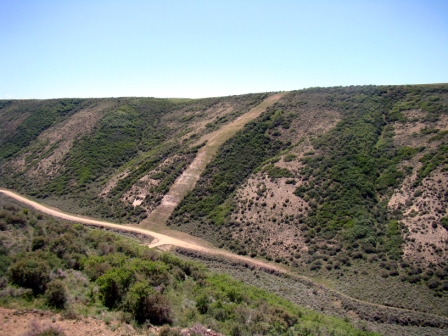
Install and maintain BMPs and erosion control devices until the desired vegetation achieves self sustaining cover. |
Technologies for Successful Reclamation
| Seeding Method |
Drilling
Broadcast
Hydroseed
Aerial Seeding
Dozer broadcasting and slope tracking
All Broadcast Seeding raked or harrowed into soil |
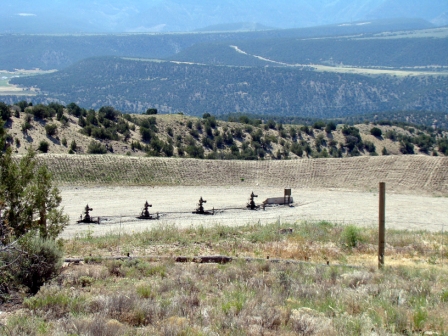
Encana uses seeding mats for interim reclamation on a well pad in Parachute, CO. |
| Mulch and Erosion Control Fabrics |
Innovation in Flexible Growth Medium (FGM)
Bonded Fiber Matrix (BFM), and Ectomycorrhizae (ECM)
Straw/Hay
Hydromulch
Combination of Mulch and Structural |
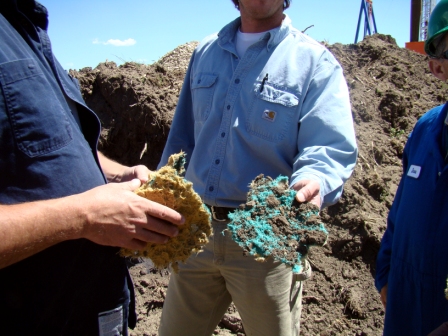
Encana uses a biodegradable mulch that has both synthetic and natural fibers for increased durability |
| Structural BMPs |
Erosion Logs
Silt Fence
Sediment Tubes
Erosion Control Blankets |
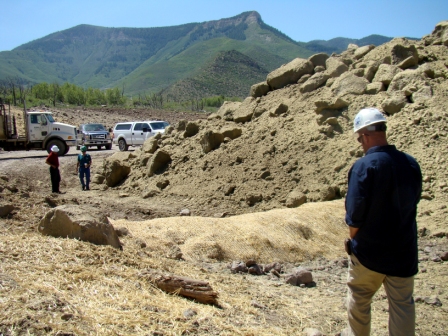
Encana uses erosion blankets and waddles |
Economic Benefits
The upper management in energy companies needs to recognize the importance of establishing an adequate reclamation budget. Without adequate funding, environmental staff will not have sufficient funds for initial reclamation. Though efforts in reclamation and stormwater management do not add to the bottom line profitability and stock value for energy development, energy companies can add to their bottom line when consulting and contracting efforts are on track and geared towards successfully completing initial reclamation. Lease operating expenses increase due to the direct and indirect costs associated with failed initial reclamation. This cost associated with failed reclamation can result in a 50% cost increase over initiating proper initial reclamation techniques. Adequate funds paired with the Lifespan Planning Approach can help eliminate these costs.
Direct Costs of Reclamation Failures |
Indirect Costs of Reclamation Failures |
Between Pioneer and Encana the costs are estimated to be between $13,000-$43,000 per acre for the following reclamation failures:
Retrieving sediment from erosion and sediment events, including off-site
Replacing sediment or other suitable materials in washout areas
Regrading
Reseeding
Replacing and adding BMPs
Extending the duration of weed management activities
Additional maintenance and inspection costs |
Increased staff and consultant time:
Oil and Gas Environmental Staff or private consultants approximate rates are $100.00 per hour. Thus several thousand dollars could be wasted easily in dealing with poor reclamation and erosion issues
Tarnished agency and landowner relationships:
What kind of price tag do you put on production delays due to challenging relationships?
Potential regulatory and non-compliance:
What are the potential costs associated with fines? |
Conclusions
As Encana has discovered, there can be significant economic, public relations, and environmental benefit to proper initial reclamation. When well pads are designed in accordance with the Lifespan Planning Approach, well pads are designed and constructed with final reclamation in mind. Appropriately designed sites require little interim maintenance, and are more efficiently closed upon final reclamation, with a greater chance of reclamation success. Due to its implicit benefits, the Lifespan Planning Approach has been recently adopted by other companies, such as Pioneer, in an attempt to achieve regulatory compliance in a cost effective manner.
Further Research and News Articles
Encana Loans Grand Teton Innovative Planking for use in Construction Project
Grand Teton National Park officials plan to use Encana’s innovative planking technology and materials to protect vegetation during a park construction project this year
http://trib.com/news/state-and-regional/article_ea99adde-86a6-57a6-99ee-fc1bbf8c4398.html (Trib.com: Wyoming’s Online News Source)
Encana Uses Mats to Protect Wildlife Habitat
http://www.pinedaleonline.com/news/2005/12/Encanausesmatstoprot.htm (Encana USA, Pinedale Online)
Farm Foreman’s Dream
Generous contributions from Encana and other energy companies help Upper Colorado Environmental Plant Center purchase a new combine for range management.
http://www.plant-materials.nrcs.usda.gov/pubs/copmcnl8583.pdf (High Altitude News: Upper Colorado Plant Center)
Fostering Sound Range Management
South Side CD partnered with Encana Gas Company to provide a cost share program to revegetate range and pasture land that has continued through this year.
http://www.colorado.gov/cs/Satellite?c=Page&childpagename=Agriculture-Main%2FCDAGLayout&cid=1178305637677&p=1178305637677&pagename=CDAGWrapper (Colorado State Conservation Board: South Side Conservation District)
Preventing Soil Erosion
Encana Gas Company participates in Revegetation Cost Share program to address soil erosion.
http://www.colorado.gov/cs/Satellite?c=Page&childpagename=Agriculture-Main%2FCDAGLayout&cid=1178305637677&p=1178305637677&pagename=CDAGWrapper (Colorado State Conservation Board: South Side Conservation District)
Oil and Gas Companies Honored for Environmental, Community Efforts
Encana Oil & Gas (USA) was recognized for its work to keep residents in the Erie area informed of its activities in their community. The company mailed “Courtesy Notices” to any resident within a half mile of Encana activity which describe the proposed operation and provide a “Feedback Phone Line” with cell phone numbers of Encana employees who can answer questions in person. Encana also established a Google-based activity map is available through Google that provides additional information, since initialing these programs; Encana has experienced an 80% reduction in complaint calls in this area. Encana has conducted similar outreach in northwestern Colorado.
http://coloradoenergynews.com/2009/07/oil-and-gas-companies-honored-for-environmental-community-efforts/ (Colorado Energy News, July 20th, 2009)
Field Tour of Encana’s Reclamation BMPs in Action:
The Importance of Lifespan Planning and Passionate Employees
Written by Carolyn Brock, University of Colorado at Boulder
At a time when resource availability and population size are coming to a head, oil and gas companies are pressured to supply the fuel needed to keep our society moving while preciously guarding and protecting other natural resources in extraction areas. This task is anything but simple and straight-forward and many oil and gas companies are at a loss about how to meet both needs that sometimes seem to be at odds. As a company, Encana has made strides toward a solution.
In the past, oil and gas development occurred when several conglomerate companies acquired mineral rights in an area and proceeded with exploration, drilling and production. These companies planned and functioned quite autonomously, and during reclamation, many of the reclamation obligations seemed to fall outside the responsibility of any one company. Because of this, certain reclamation goals fell through the cracks or were simply abandoned and negative surface impacts occurred as a result of poor planning and land management. Solving this problem, as Encana has discovered, is the key to a successful oil and gas operation.
On June 27th, 2010 I had the opportunity to participate in a field tour of one of Encana’s oil and gas production sites near Parachute, Colorado. The town is nestled at the foot of breathtaking mountains and buttes under a sky of forget-me-not blue. When I got to the meeting spot, Encana Reclamation Coordinator Bryan Whitely stood outside his white pick-up truck with hard hats, jumpsuits and protective eyewear, clearly ready to start the day. As we piled in to head out, Whitely began passionately explaining how things had changed in the industry. “Contrast is a beautiful thing” he said as we pulled up to our first stop.
Whiteley explained that before Encana had acquired the land in the pasture before us, a cattle rancher owned and grazed there. Whiteley said that before they bought the property, the land manager had given his cattle free range and did little to maintain the meadow. The cattle compacted soils, caused erosion, upset nutrient balances and native plant abundances, and introduced noxious and invasive weeds. Since then, Encana has restored the land to its pre-grazed condition. Whiteley revealed that he get’s deep satisfaction from being able to leave the land in a better condition than he finds it, and assures that whenever possible, Encana makes a policy of doing so.
Whitely explained how they had used a process known as land-forming to introduced hydrologic variation in the landscape, more in keeping with the land’s natural state, in order to promote native establishment and diversity. When asked about seed mixes used, Whiteley revealed that the mix was of his own design based on his immense knowledge of range management and concluded by emphasizing that “in a range like this, only natives will work.”
Whitely then took us to production sites that had been designed and constructed before he began working for Encana at a time when the impacts of oil and gas development were poorly understood. The sites were stark. There was no question to the casual observer about whether or not they were looking at an active well pad. Many of these early sites had the appearance of a hill with the top cut off with large storage tanks and production equipment visible from all sides of the platform. The sites were poorly planned, and sometimes had issues with stormwater drainage and inadequate berming. Berming, as Whiteley explained, was key in visual and noise impact reduction as well as a crucial component of spill containment and pollution prevention.
Following our first look at a well pad, we got back into the car to head to more recently designed and constructed production sites. Upon arriving at one such site, I immediately understood what Whiteley had meant when he said “contrast is a beautiful thing.” Compared to the other site, the newer well pad’s elegant efficiency was almost invisible until you were walking right up to it. Whiteley explained that using a Lifespan Planning Approach to design sites was the key to Encana’s reclamation success.
Whitely excavates the area to be drilled so that he can form the resulting soil into large berms. These berms completely encircle the well pad, offering spill containment, noise and visual impact reduction, and prevent stormwater pollution and sedimentation by containing and filtering them on site. The site’s elegance resides in the fact that Whiteley seeds and mulches the berms to minimize soil loss by erosion during production, making the well pad, from a distance, look like nothing more than a gentle hill. When production activities stop, the well can be completed and the top soils simply pushed back to their original position. Whitely then land forms the area to restore its natural hydrologic patterns, mulches, and finally re-seeds the area. Whiteley explains that a site like this one requires almost no maintenance until final reclamation due to wise planning. Using such a system has contributed to Encana’s reputation and has helped to significantly reduce production costs.
We visited many well pads over the day, but all the newer sites developed with the Lifespan Planning Approach in mind had several features in common. They all had extensive earthwork that was designed specifically based on the contours and hydrologic patterns of the surrounding area, had mulch and interim seeding to minimize erosion, water loss and invasive seed colonization, and had waddles and slash berms to filter sediment. When asked about his job and the physical and metal load that was required to make such efficient and sustainable well sites, Whiteley merely said that “The great thing about my job is that all I need to do is the right thing.” His passion for doing what is right extends to the land he manages, the oil and gas that gets extracted there and the citizens in and around producing areas he interacts with. This genuine and intelligent attitude was clearly reflected in the work Whiteley oversees and in the attitudes of the employees he manages.
All things considered, the management practices implemented by Encana are simple, cost effective measures that have proven to be extremely successful. The Lifespan Planning Approach they’ve adopted as their industry standard, along with well educated, passionate and professional employees has made Encana the respectable and responsible company that it is today.
To find out more about Encana and their reclamation and revegetation activities go to www.encana.com or contact the Parachute Field Office at 970-285-2600
|











